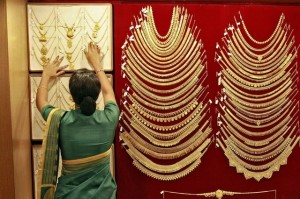
A saleswoman arranges a gold necklace inside a jewellery showroom in Kochi, India. Sivaram V / Reuters
When actress Kate Winslet picked three glittering pieces of diamond jewellery made in India to wear to last month’s Oscars, the Indian press exulted that it marked a big moment for the country’s jewellery-making skills and craftsmanship. It had literally arrived on the red carpet, said the newspapers. The jubilant mood started to fade just days later, after the Indian government laid out its annual budget. A local sales tax on gold and diamond jewellery was reintroduced after a gap of four years and record import duties were left intact.
The new regulations came as the price of gold hit a 13-month high internationally, adding to India’s funereal sense of doom. The new sales tax of 1 per cent will make it more expensive for Indians to indulge in their time-honoured ritual of buying large amounts of gold. More to the point, it will bring the whole Indian jewellery sector within the tax net and liable to scrutiny by officialdom.
The government’s move prompted a nationwide strike by thousands of jewellers, who argued that it would introduce unnecessary red tape, put small retailers out of business and imperil the livelihood of an estimated 10 million artisans. The All India Gems and Jewellery Trade Federation suggested that it was simply impractical to impose excise duty on so large and “unorganised” a sector.
But that seems to be precisely the point. There may be rich pickings for any Indian government resolute enough to push through with streamlining the buying and selling of gold in the world’s second biggest consumer. About $1 trillion (Dh 3.74tn) worth of gold — 22,000 tonnes — is privately held in India, according to the World Gold Council. In 2011, India imported more gold than any other country, about 1,000 tonnes, or a fifth of global annual supply. It was the same amount as sat in the central bank vaults of Switzerland at the time. Until 2013, when China became the fastest-growing market for gold, India continued to import more than other countries. At the end of 2014, the World Gold Council said jewellery accounted for 58 per cent of global demand for gold and that India and China constituted 57 per cent of this.
Even the council, whose members comprise leading gold mining companies, admits to mild stupefaction at the way in which “India’s appetite for gold defies market conditions”. Despite a 400 per cent rise in the rupee gold price over the past decade, it says, gold demand from Indian consumers continues to grow.
There are sound cultural reasons for this habit and a number of less savoury ones aimed at beating the system and the taxman.
Indians have a fundamental belief that gold is auspicious and an enduring and portable store of value. That makes sense because only a third of Indians have bank accounts. But brides are still weighed down by jewellery, and dowries rich in glittering sets of matching gold items continue to be the traditional way of indicating a family’s wealth and aspirations, no matter if they are so poor it costs them their life savings.
The mania for gold goes the whole arc from social standing to spiritual life, with Hindu temples the traditional repositories for gold. The Padmanabhaswamy Temple in Thiruvananthapuram, capital of the southern Indian state of Kerala, is the world’s richest Hindu shrine. Devotees believe the state’s erstwhile rulers were wise to store gold there both as an offering and as an insurance against famine.
But there is a fundamental problem with 21st century India’s insatiable appetite for gold. In 1982, India consumed only 65 tonnes. Until 1990, imports were all but banned. Deregulation has meant skyrocketing demand, mostly from rich people seeking to store wealth without paying tax and by speculators and crooks trying to hide ill-gotten gains through an asset that the authorities could not track.
Until now, gold sales in India conspicuously lacked documentation, one reason that some political scientists have linked the booming demand to the rise in corruption.
This is where the new regulations come in. Prime minister Narendra Modi’s government regards gold as a highly subsidised commodity, on a par with essentials for poor Indians, such as cooking gas, kerosene, electricity and railway fares. More importantly, it says that the top 20 per cent of India’s earners consume 80 per cent of the gold. In November, it announced an eight-year sovereign gold bond scheme to encourage Indians to buy paper rather than the metal. It also tried to monetise “idle gold” — jewellery and bars unproductively stored in temples and private homes — by offering to pay interest on deposits made into banks. The idea was for the banks to auction off the gold or lend it to jewellers to save on imports. In December, the government made it mandatory for customers to disclose their tax code for high-value purchases of gold.
It’s clear that the Indian government sees its attempts to regulate the consumption and transactional use of gold as a necessary and overdue way to modernise the economy. India’s household savings rate is high, but as much as half remains as unavailable as if it were stored under the mattress.
In real terms, the Indian appetite for gold has widened the country’s current-account deficit. Huge amounts of foreign currency flow out of the country every year to buy bullion. With India having recently overtaken China as the world’s fastest growing major economy, the pressure is on to achieve that incipient potential. But with gold, as with much else in India, the new rules will be only as good as their enforcement.

